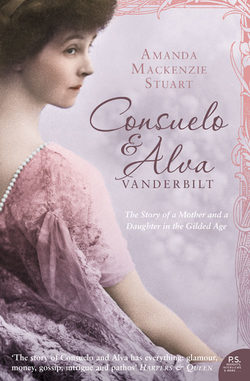Consuelo and Alva Vanderbilt: The Story of a Mother and a Daughter in the ‘Gilded Age’

Реклама. ООО «ЛитРес», ИНН: 7719571260.
Оглавление
Amanda Stuart Mackenzie. Consuelo and Alva Vanderbilt: The Story of a Mother and a Daughter in the ‘Gilded Age’
Contents
PREFACE
Prologue
1 The family of the bride
2 Birth of an heiress
3 Sunlight by proxy
4 The wedding
5 Becoming a duchess
6 Success
7 Difficulties
8 Philanthropy, politics and power
9 Old tricks
10 Love, philanthropy and suffrage
11 A story re-told
12 French lives
13 Harvest on home ground
Afterword
NOTES
BIBLIOGRAPHY
INDEX
PRAISE
ACKNOWLEDGEMENTS
Copyright
About the publisher
Отрывок из книги
& ALVA
VANDERBILT
.....
The impact on Alva of the move to Paris would have many consequences in the decades to follow: for American architecture, for the Vanderbilts and for Consuelo. Now in her early teens, she fell passionately in love with France, and above all with its history, art and architecture. In New York she had been just as resistant as the Commodore to attempts at formal education (‘I could not learn from impersonal pages. I wanted the contact of mind with mind. I liked the friction of thought it engendered,’52 she remembered later.) Now she responded to the clarity, rigour and competitiveness of French schooling which appealed to both ambition and pride; she particularly liked the French approach to learning history which she thought made sense. At one point she even demanded to go to a boarding school run by one Mademoiselle Coulon. She enjoyed this too, though she continued to prove a most difficult girl to handle and only stayed for about a year.
Much of Alva’s French education, therefore, was a freelance affair in the hands of French and German governesses, with trips to places that appealed to Miss Alva Smith. Thanks to the ever-expanding French railway system, there were frequent visits to the great Renaissance chateaux on the Loire, and to Versailles. It is understandable, given her dominant personality and her love of history, that Alva would be drawn to the magnificent architecture of both the French Renaissance and of the Bourbons. It is easy to imagine her walking in awe through the Hall of Mirrors at the Palace of Versailles, or believing that the apartments of Madame de Pompadour really belonged to her, or sketching the Petit Trianon for the umpteenth time – doubtless followed by a breathless governess much relieved to have found a way of passing the time in such an acceptable manner.
.....